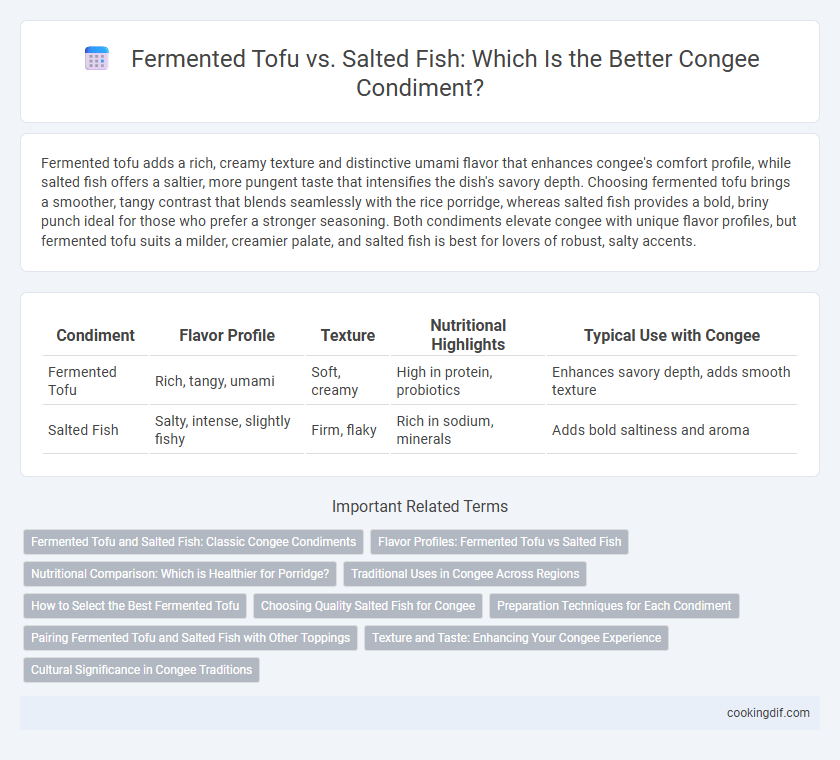Fermented tofu adds a rich, creamy texture and distinctive umami flavor that enhances congee's comfort profile, while salted fish offers a saltier, more pungent taste that intensifies the dish's savory depth. Choosing fermented tofu brings a smoother, tangy contrast that blends seamlessly with the rice porridge, whereas salted fish provides a bold, briny punch ideal for those who prefer a stronger seasoning. Both condiments elevate congee with unique flavor profiles, but fermented tofu suits a milder, creamier palate, and salted fish is best for lovers of robust, salty accents.
Table of Comparison
| Condiment | Flavor Profile | Texture | Nutritional Highlights | Typical Use with Congee |
|---|---|---|---|---|
| Fermented Tofu | Rich, tangy, umami | Soft, creamy | High in protein, probiotics | Enhances savory depth, adds smooth texture |
| Salted Fish | Salty, intense, slightly fishy | Firm, flaky | Rich in sodium, minerals | Adds bold saltiness and aroma |
Fermented Tofu and Salted Fish: Classic Congee Condiments
Fermented tofu and salted fish are classic congee condiments that enhance the dish's umami flavor profile. Fermented tofu offers a creamy texture and pungent aroma, rich in probiotics that aid digestion, while salted fish provides a salty, savory depth with a slightly chewy consistency. Both ingredients complement the smoothness of congee, balancing its mild taste with bold, traditional Chinese flavors.
Flavor Profiles: Fermented Tofu vs Salted Fish
Fermented tofu offers a rich, creamy texture with a pungent, umami-packed flavor that enhances congee by adding depth and a slightly tangy taste. Salted fish delivers a bold, intensely salty and savory profile with a flaky texture, imparting a robust oceanic aroma that complements the mildness of porridge. Choosing between the two depends on whether a smoother, fermented tang or a potent, savory saltiness is preferred to elevate the congee experience.
Nutritional Comparison: Which is Healthier for Porridge?
Fermented tofu contains probiotics and is rich in protein and calcium, supporting gut health and bone strength when added to porridge. Salted fish, while adding umami flavor, is high in sodium and may contribute to hypertension if consumed in excess. Choosing fermented tofu over salted fish enhances nutritional benefits in congee without the risks associated with high salt intake.
Traditional Uses in Congee Across Regions
Fermented tofu, known for its creamy texture and rich umami flavor, is traditionally used as a congee condiment in southern China, enhancing the porridge with its subtle tanginess and depth. Salted fish, with its intense saltiness and preserved flavor, is a staple in coastal regions like Guangdong and Hong Kong, providing congee with a distinctive savory punch that complements fresh ingredients. Both condiments play essential roles in regional congee varieties, reflecting local culinary heritage and ingredient availability.
How to Select the Best Fermented Tofu
When selecting the best fermented tofu for congee condiment, prioritize tofu with a rich, slightly tangy aroma and a deep red or golden color, as these indicate quality fermentation. Texture should be creamy yet firm, ensuring it blends smoothly into porridge without overpowering its subtle flavor. Opt for brands with minimal additives and traditional fermentation methods to achieve an authentic, savory taste that complements the mildness of congee better than salted fish.
Choosing Quality Salted Fish for Congee
Selecting high-quality salted fish for congee involves evaluating factors like texture, aroma, and salt content to ensure a balanced flavor profile. Premium salted fish should have firm flesh with a natural umami taste without excessive saltiness or off-putting odors. Properly cured and well-preserved salted fish enhances the congee's savory depth while maintaining nutritional value and a pleasant mouthfeel.
Preparation Techniques for Each Condiment
Fermented tofu is prepared by aging soybeans in a brine with red yeast rice or other mold cultures, resulting in a soft, creamy texture and complex umami flavor ideal for congee. Salted fish involves curing fresh fish with coarse salt, allowing it to ferment and dry over weeks, creating a strong, salty taste with a firmer, flaky texture suited as a savory congee topping. Each condiment's unique fermentation and curing techniques produce distinct flavor profiles that enhance the creamy, mild base of porridge.
Pairing Fermented Tofu and Salted Fish with Other Toppings
Fermented tofu and salted fish bring distinct umami flavors that elevate congee's mild base while complementing toppings like chopped scallions, preserved mustard greens, and shredded ginger. Fermented tofu's creamy texture harmonizes with crispy fried shallots and fresh cilantro, creating a rich yet balanced taste. Salted fish pairs well with crunchy peanuts and pickled vegetables, adding depth and a salty contrast that enhances the overall congee experience.
Texture and Taste: Enhancing Your Congee Experience
Fermented tofu offers a creamy, smooth texture with a rich umami flavor that enhances congee by adding depth and subtle tanginess. Salted fish provides a firmer, flaky texture with intense salty and savory notes, delivering a bold contrast that intensifies the overall taste of congee. Choosing between fermented tofu and salted fish depends on whether you prefer a mellow, silky complement or a robust, punchy seasoning for your congee.
Cultural Significance in Congee Traditions
Fermented tofu and salted fish hold distinctive places in congee traditions, each reflecting unique cultural significance across different regions. Fermented tofu, with its rich umami flavor and creamy texture, is revered in southern Chinese cuisine, symbolizing home-style comfort and preservation techniques passed down through generations. Salted fish, commonly used in Cantonese congee, embodies ancestral culinary heritage and is often associated with festive occasions, showcasing the interplay between preserved seafood and rice porridge in regional identity.
Fermented Tofu vs Salted Fish for Congee Condiment Infographic

 cookingdif.com
cookingdif.com